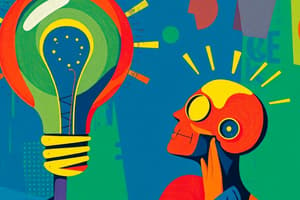Podcast
Questions and Answers
What is the main difference between invention and innovation?
What is the main difference between invention and innovation?
- Invention focuses on applying new ideas, while innovation revolves around creating something new.
- Innovation refers to the creation of something new, while invention involves implementing existing concepts.
- Invention is the birth of new ideas, while innovation is the application, use, and impact of those ideas on society. (correct)
- Innovation involves the creation of new concepts, while invention involves the practical application of ideas.
Which best describes the relationship between invention and innovation?
Which best describes the relationship between invention and innovation?
- Innovation solely relies on pre-existing inventions without any further development.
- Invention sparks innovation, and innovation leverages inventions to make societal changes. (correct)
- Innovation drives the creation of inventions but has no impact on society.
- Inventions have no impact on innovation processes.
Why was the telephone invented according to the text?
Why was the telephone invented according to the text?
- To revolutionize the dissemination of knowledge.
- To create a more efficient and powerful means of transportation.
- Out of curiosity and creativity.
- As a response to the need for efficient long-distance communication. (correct)
What motivated Thomas Edison to invent the light bulb?
What motivated Thomas Edison to invent the light bulb?
Which statement best characterizes the role of innovation?
Which statement best characterizes the role of innovation?
Why is curiosity mentioned as a driver of invention in the text?
Why is curiosity mentioned as a driver of invention in the text?
What is the relationship between invention and innovation according to the text?
What is the relationship between invention and innovation according to the text?
What can drive innovation, as mentioned in the text?
What can drive innovation, as mentioned in the text?
How did the invention of the personal computer impact the computing industry?
How did the invention of the personal computer impact the computing industry?
What role does innovation play in making inventions useful to society?
What role does innovation play in making inventions useful to society?
How did the invention of the X-ray machine contribute to medical imaging?
How did the invention of the X-ray machine contribute to medical imaging?
What is the key takeaway about inventions and innovation from the text?
What is the key takeaway about inventions and innovation from the text?
Flashcards are hidden until you start studying
Study Notes
Inventions and Innovation: The Interplay of Creativity and Practicality
Inventions and innovation are often used interchangeably, but they are distinct concepts that intertwine to drive progress and change. Invention refers to the creation of something new, while innovation involves the application, use, and impact of an invention on society. In this article, we will explore these concepts and the role they play in shaping our world.
Invention: The Birth of New Ideas
Invention is the process of creating something new, whether it's a device, a tool, or a concept. This could include anything from the wheel, which revolutionized transportation, to the printing press, which revolutionized the dissemination of knowledge (). Invention is the spark that ignites the cycle of innovation.
Invention is often driven by necessity. For example, the invention of the telephone was a response to the need for efficient communication over long distances (). Similarly, the invention of the internal combustion engine was a response to the need for a more efficient and powerful means of transportation ().
Invention can also be driven by curiosity and creativity. For instance, the invention of the light bulb was a result of Thomas Edison's fascination with electricity and his desire to create a practical source of light ().
Innovation: The Application and Impact of Inventions
Innovation is the process of applying new inventions and ideas to real-world situations. It involves the introduction of new methods, products, or services that improve upon existing ones or create entirely new markets.
Innovation can be driven by a variety of factors, including changing consumer needs, technological advancements, and market competition. For example, the invention of the personal computer led to a wave of innovation in computing, with companies developing new software, hardware, and applications to meet the needs of consumers and businesses ().
Innovation can also be driven by a desire to solve specific problems. For example, the invention of the X-ray machine led to a wave of innovation in medical imaging, with companies and researchers developing new techniques and technologies to improve diagnostic accuracy and patient outcomes ().
The Interplay of Invention and Innovation
Invention and innovation are intertwined, with each driving the other in a cycle of progress and change. Invention provides the raw material for innovation, while innovation brings inventions to life and makes them useful to society.
For example, the invention of the smartphone led to a wave of innovation in mobile computing, with companies developing new operating systems, applications, and services to meet the needs of consumers (). This innovation, in turn, led to the development of new inventions, such as the iPhone's touchscreen interface and the iPad's tablet form factor.
Similarly, the invention of the internet led to a wave of innovation in digital communication, with companies developing new protocols, applications, and services to meet the needs of consumers and businesses (). This innovation, in turn, led to the development of new inventions, such as the World Wide Web and the search engine.
Conclusion
Inventions and innovation are two sides of the same coin, each driving the other in a cycle of progress and change. Invention provides the raw material for innovation, while innovation brings inventions to life and makes them useful to society. By understanding and fostering both, we can continue to shape our world and solve the challenges we face.
Studying That Suits You
Use AI to generate personalized quizzes and flashcards to suit your learning preferences.




